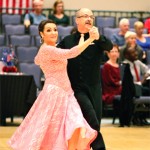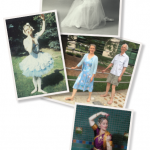As suspected, the studio was packed with wanna-be dancers. However, the directors were personable, excited and clearly loved teaching salsa, making the experience “awesome,” says Dr. Dufour.
She attended lessons every week for another six weeks, learning the basic salsa steps of moving forward and backward. But she never signed up for the next level of lessons, because they interfered with her ballet lessons.
However, her friends continued taking lessons. Later that year, one of them persuaded Dr. Dufour to join Leah’s Chicas, an all-women dance team that rehearsed weekly, practicing one salsa routine that they later performed at salsa nightclubs and other dance venues in the city.
“There were probably 30 women on the team,” she says, explaining that everyone danced in a line to Santa Baby for a Christmas show. “It was meant to be supportive, inclusive and for women to have fun, learn something and then perform it.”
It was so much fun that she stopped taking ballet classes, which were very structured and taught difficult techniques that really couldn’t be performed at any nightclub. Salsa dancing became her new addiction. Since then, she has rehearsed her way up to become an intermediate dancer and joined Gusto, a partner performance team at the same studio—Salsa y Control—in September 2014.
Dancers practiced the choreography for about six months with various partners to learn their unique dance styles and then instructors linked them to the partner they were most in sync with to perform.
“There’s definitely structure to the dance, but you have the ability to make up your own steps and insert your own personality into your dancing,” says Dr. Dufour. “When dancing, the leader or your partner breaks apart from you, which is your time to shine. Maybe you look silly, maybe you don’t. You can do whatever you want, and that’s fun.”
Nearly two years later, however, she was ready to move on to something new. Last July, she began training in a new Latin dance called bachata, which, unlike salsa, she says, moves from side to side and can be more romantic.
Alma Latina, the Mexican-based company that teaches bachata, creates the choreography for each routine, she says, which is taught at the same time at each of its franchise studios throughout the world. This way, she says if dancers travel to other cities or countries, they can visit any franchise studio and perform the same routine together.
Mixing Work with Pleasure
Despite her busy work and dance schedule, Dr. Dufour stills find time to volunteer.


